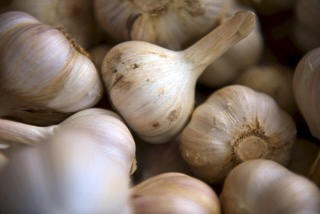
(2/4) "I’ve never met anyone who grows garlic", a workman said to me when I shared some of my freshly pulled harvest.
"Seriously?", I replied. In the back of my mind there was a much longer track running. It went something like this…. "I can’t believe that you don’t know other people who grow garlic. It is the easiest crop that I grow- reliable results with minimal effort and it stores well so I am still enjoying the fruits of my labor throughout the winter." Since he probably wanted
to get home to his family for dinner, I spared the guy my diatribe. You, however, are probably perusing the paper while drinking coffee, so I will expound.
Years ago, I had a similar experience with garlic, except I was the recipient. My neighbors are seasoned and masterful gardeners. Luckily for me, they shared a head of garlic and advice on how to manage it. A gift of one head of garlic and a little encouragement was all it took to get me hooked.
I have garlic on my mind today because now is the time to order it. As you are perusing catalogs, be sure to add some to your list. Don’t miss out on the opportunity to get the best selection of varieties. The garlic will not be delivered until fall, since that is the best time for planting in the mid-Atlantic. Buy certified, disease free bulbs. Otherwise, you may
introduce disease organisms into your garden.
 There are two types of garlic that you can grow. Softneck varieties have a mild flavor. The heads tend to be smaller but they can be dried and braided for storage. Hardneck varieties tend to be favored by garlic lovers as they have a more pungent flavor. They form a flower stalk called a garlic scape. Scapes
should be cut early and can be used like scallions. If left too long, they will become woody and reduce the size of the cloves. Elephant "garlic" is actually a kind of leek that forms large, mild flavored cloves.
There are two types of garlic that you can grow. Softneck varieties have a mild flavor. The heads tend to be smaller but they can be dried and braided for storage. Hardneck varieties tend to be favored by garlic lovers as they have a more pungent flavor. They form a flower stalk called a garlic scape. Scapes
should be cut early and can be used like scallions. If left too long, they will become woody and reduce the size of the cloves. Elephant "garlic" is actually a kind of leek that forms large, mild flavored cloves.
Garlic requires good drainage. If drainage is not ideal, plant cloves in raised beds. Amend the soil with compost prior to planting in early to mid-October, 1-2" deep and 4-6" apart. This allows the root system to establish itself before winter, preventing frost heaving. A layer of straw mulch will also help to protect the roots and reduce weeds. The garlic will remain
dormant in the ground until spring, when leaves fully emerge and increasing day-length triggers the plant to form cloves.
Harvest bulbs in late June or early July when 40-60% of the leaves have yellowed. If you wait longer, the heads will split and storage life will be significantly reduced. Brush excess soil off and place the bulbs in a well-ventilated, shady area to cure. A box fan is ideal for air movement. Once the heads are dry, roots can be trimmed off and tops can be removed from
hardneck varieties. Softneck varieties can be braided.
If you take my advice, this time next year you will find yourself enjoying garlic from your pantry and dreaming about another variety of garlic you’d like to try. Don’t miss out on growing this forgiving and rewarding crop. I am grateful to my neighbors for getting me started years ago. They gave me great advice and the encouragement that I needed to give it a go. The
only thing I would add to the advice they gave me is this: grow, share, eat, repeat, grow, share, eat, repeat.
Read other articles by Susie Hill